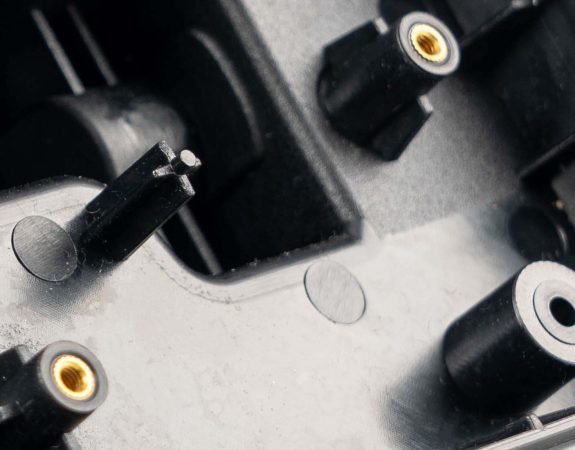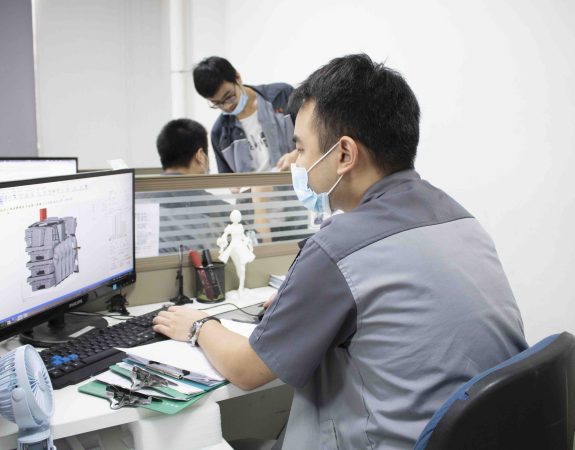Design for Manufacturability (DFM) is an engineering practice and process that focuses on optimizing the design of products or parts to make them easier to manufacture, with the end goal of producing a better product at a lower cost. Adopting a DFM mindset ensures the materials and components are compatible and easily accessible throughout production. It also helps businesses speed up their product development process, ultimately resulting in well-designed parts that are easier to manufacture and cost-effective to produce.
The DFM process adheres to 5 key principles or set of guidelines: (1) Process, (2) Design, (3) Material, (4) Environment, (5) Testing. This section explains all five principles.
1. Process: Choosing a manufacturing method for your product. Analysing the process by which each part is made can lead to simpler setups and operations to reduce part cost. Well-designed parts should be optimized for their manufacturing process.
2. Design: The more complex the design, the higher the risk. Keep your designs simple. This is in terms of cost, manufacturing, assembly, use, and maintenance. Simplifying your design cuts down on the time and inventory needed to make your product, which correlates to its cost.
3. Material: Choosing the right materials in the early stages can save you time and money. Your choice of materials can impact your cost, part quality, and manufacturing method. Consider these points: What properties does your part require? How many cycles should it last? Are there any weight requirements?
4. Environment: Each part of your product must be designed for the environment it will be used in. You must take every operating condition into account. All parts of the product must be able to perform in these conditions.
5. Testing: Lastly, make sure to do proper and thorough testing. Ensure the product and its components comply with all industry standards. These standards can be industry, internal, or company standards, and must be considered in all stages of DFM.
DFM plays a significant role in the success of a product in the market. Especially when it comes to tooling and injection moulding, DFM analysis is crucial for ensuring efficient production and high-quality components by optimizing the design for manufacturing and assembly.
Successful DFM analysis minimizes cost while retaining – or even increasing – the performance of a part or product, along with other long-term benefits. Here are the nine key benefits of DFM:

Start your FREE DFM and project review
Here are the 3 key considerations for successful DFM implementation:
Start As Early As Possible
Ideally, DFM analysis needs to occur early in the design process, well before tooling has begun. Early collaboration between designers, engineers, and manufacturers also ensures that all aspects of the product lifecycle are considered. Good DFM then needs to be quickly followed up with effective communication for successful timeline execution.
Rapid Prototype and Test
Utilize rapid prototyping to refine designs iteratively and create a more robust final product. A big part of successful DFM involves fathering feedback from prototypes and initial production runs to make necessary design adjustments. Today, simulation softwares are also increasingly being employed to analyze and optimize the injection moulding process.
Identify opportunities for DFM techniques
Follow established Design for Manufacturing (DFM) guidelines to ensure the manufacturability of your design. This includes following recommended wall thickness, draft angles, parting lines, gating choice, etc., to optimize your part and minimize the risk of defects. Also, closely work with your designers and mould manufacturers to identify wastage in manufacturing and provide suggestions for more efficient and sustainable alternatives.
Applying DFM to plastic injection moulding can be challenging because there are many different types of plastic resins with particular mechanical and chemical properties. Designers, therefore, need to work within the limitations of the resin as well as the material used to make the mould tool. Here are some DFM tips and rules for designing better moulded parts:
Material Selection:
Wall Thickness:
Draft Angles:
Ribs and Gussets:
Bosses:
Gating and Runner System:
Ejector Pins:
Surface Finish:
Tolerances:
Assembly Considerations:
It really depends on the quality of the design you start with. If the design is clean and no major issues are found, DFM feedback for tooling and injection moulding projects usually takes 1-2 days. But depending on the design complexity, number of questions, thoroughness of the answers, and how quickly both parties (manufacturer and client) are able to come to an agreement, you might be waiting a week or more. Once the design is deemed manufacturable and ready for the next step, tooling production will begin immediately.

T1 samples as fast as 2 weeks
Submit your 2D and 3D CAD drawings to our site contact form along with your injection moulding project details and our engineering team will get back with a quote and thorough DFM prior to order.
